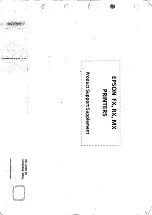
To start the RTELPD daemon process, issue the command
/usr/spool/rtel/rtelpd -s
from a
shell prompt. You can check the RTEL setup by sending data into the named pipe and seeing if it
appears at the printer.
Figure 10-24:
Checking RTEL Setup
Obviously, if the printer is a PostScript printer, a PostScript job should be sent to the pipe. Remem-
ber to add the
/usr/spool/rtel/rtelpd -s
command to the host startup files so that the
RTELPD daemon will be started automatically each time the system boots.
Once the RTELPD daemon is running, a UNIX print queue can be configured and should use the
named pipe as its output device. This allows all the normal option processing associated with
host-supplied or third-party backend programs.
10.3.5.1 RTELPD Command Line Parameters and Options
The RTELPD daemon process has a set of command line options, which are detailed in the follow-
ing table.
NOTE:
See the RTELPD man page for more information about each of these options and
what they do.
# cat /etc/hosts > /dev/rtp1
Table 10-2:
RTELPD Command Line Options
Option
Description
Usage
b
rteld spawned as a system daemon
-b
c
specify a host and service to connect to
-c
service@host
e
convert <lf> into <cr><lf>
-e
h
help screen
-h
k
kill daemon for the specified named pipe
-k/dev/pipe
kill all running RTELPD daemon processes
-kall
n
named pipe to use
-n/dev/pipe
p
specify a password for the remote service
-ppassword
r
shows all active RTELPD sessions
-r
s
start rtelpd daemons in server_hosts file
-s
v
Show version of RTEL software
-v
Summary of Contents for RapidPrint 500
Page 8: ...viii...
Page 10: ......
Page 16: ......
Page 26: ......
Page 28: ......
Page 38: ......
Page 40: ......
Page 54: ......
Page 58: ......
Page 60: ......
Page 66: ......
Page 72: ......
Page 78: ......
Page 94: ......
Page 96: ......
Page 176: ......
Page 178: ...Digital Problem Report Procedure Technical Support A 2...
Page 186: ......
















































